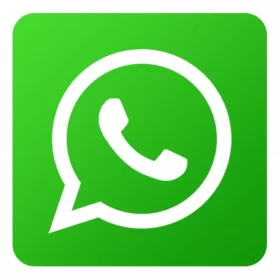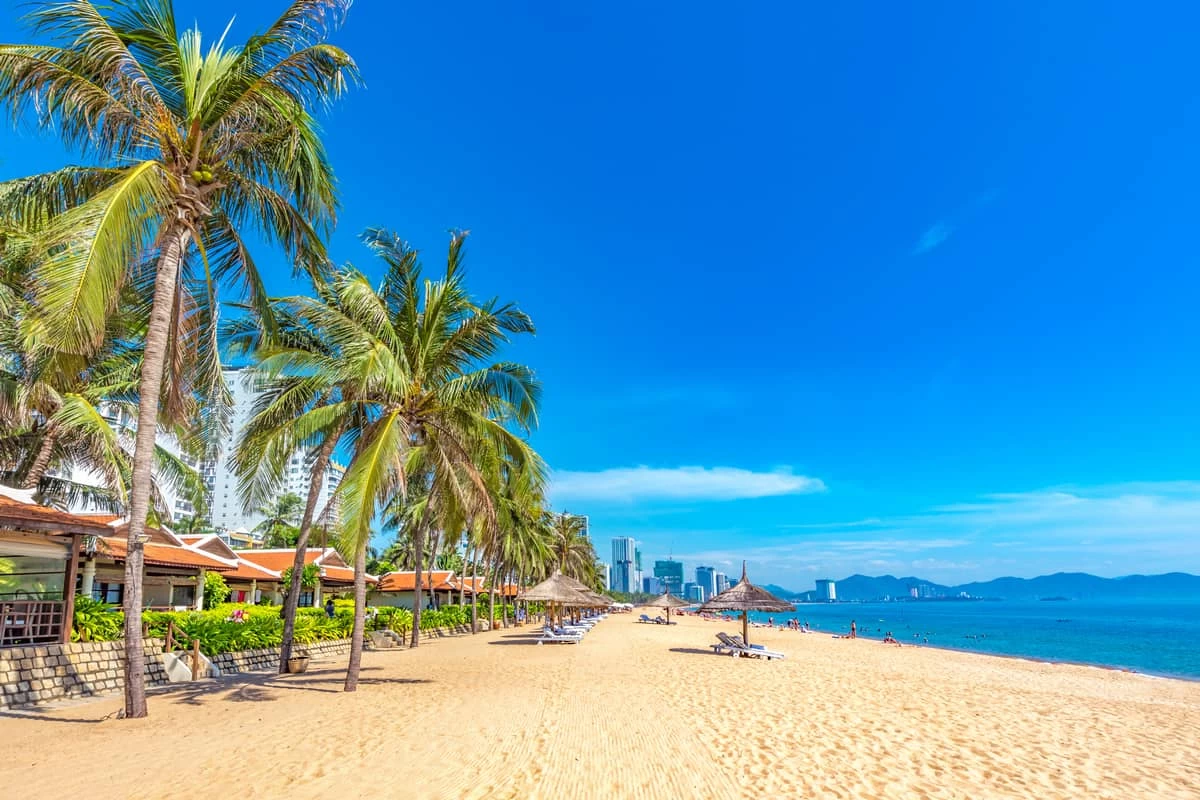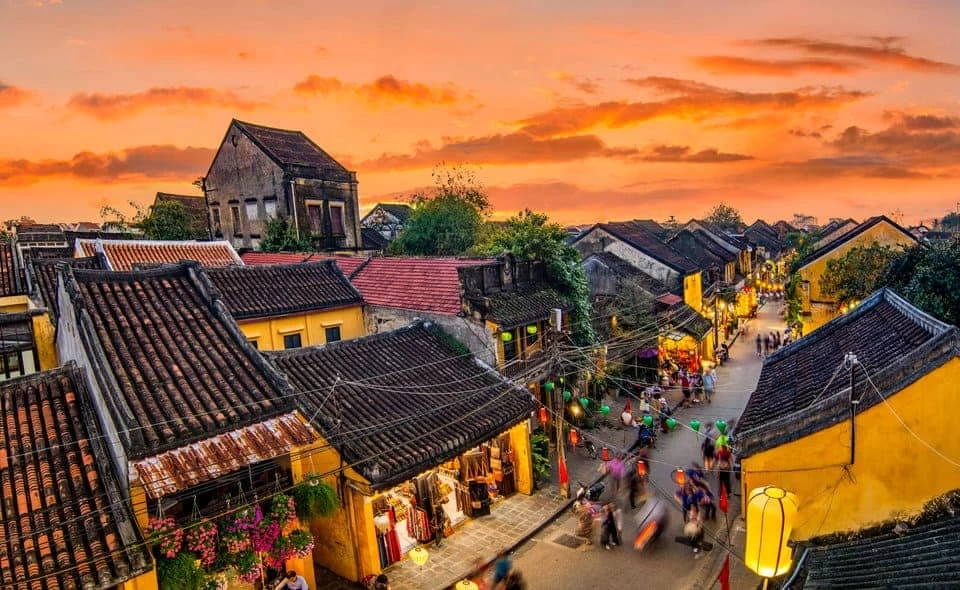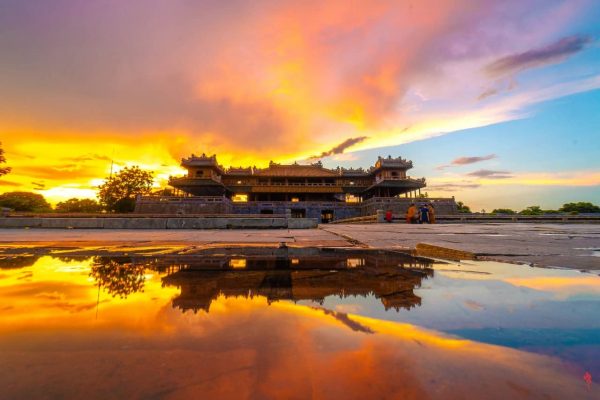
Imperial City of Hue
Hue always carries with it a quiet, gentle, and strangely peaceful beauty. Setting foot here, one is struck by its quietness, poetry, and remarkable tranquility. The allure of the Perfume River city lies not in its bustling energy but in its serene, tranquil beauty that deeply resonates with visitors.
I. Overview of Hue
1. Location of Hue
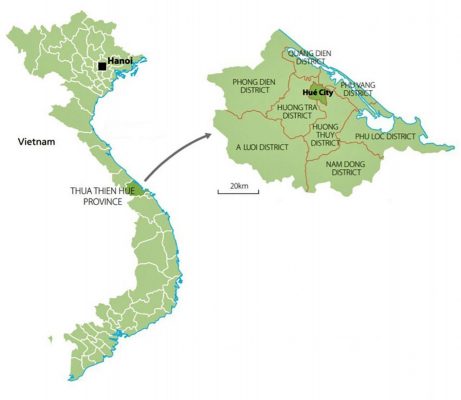
Location of Hue
Hue is situated in central Vietnam, approximately 700 km north of Hanoi and about 1,000 km south of Ho Chi Minh City. The city is located on the banks of the Perfume River, whose clear blue waters are a prominent feature of Hue. This province was once the imperial capital of Vietnam during the Nguyen Dynasty, where emperors ruled from 1802 to 1945.
2. How to Get to Hue
- By Air: If you wish to save travel time, flying to the dreamy city is advisable. Airfare prices will depend on the airline you choose. Phu Bai International Airport is approximately 14km from the city center, and you can opt for transportation via bus, taxi, or rental car with a driver.
- By Train: Traveling by train offers the experience of admiring the beautiful natural scenery along the way without the worry of motion sickness. However, this journey can take between 13 and 19 hours, depending on your departure point from Hanoi or Saigon, so plan accordingly.
- By Bus: Sleeper buses are a more budget-friendly option. It’s advisable to choose buses departing in the evening, where you can sleep overnight and arrive in the morning.
II. History of Hue
1. Hue and the Nguyen Dynasty
Hue served as the imperial capital of Vietnam during the Nguyen Dynasty, from 1802 until 1945, when the country was unified under the Nguyen emperors. The city was the heart of political, cultural, and religious life in Vietnam during this period, shaping its distinctive heritage.
The Nguyen emperors made Hue their residence and established a grand imperial court, leaving an indelible mark on Vietnam’s historical and cultural identity. This era’s influence can be seen in the city’s architectural masterpieces, rituals, and the courtly traditions that permeate Hue’s cultural landscape.
The Nguyen Dynasty left behind a wealth of royal architecture, encompassing majestic palaces, grand halls, temples, and tombs that reflect their dedication to Confucian values, art, and spirituality. The dynasty’s imperial legacy continues to influence Vietnamese society, with traditional rituals, attire, and royal customs still practiced or reenacted for cultural preservation. The city remains the best place to experience the grandeur of Vietnam’s last monarchy and its impact on Vietnamese civilization.
2. UNESCO World Cultural Heritage
In 1993,Imperial City of Hue and associated relics were recognized by UNESCO as a World Cultural Heritage site, cementing its global significance. The recognition honors the city’s unique collection of historical sites and its role as a cultural symbol of Vietnam.
The Imperial City of Hue, a walled fortress and palace complex, is the centerpiece of this heritage site. Inspired by traditional Chinese palace design, the Imperial City boasts a complex layout with four distinct sections: the Imperial Enclosure, the Forbidden Purple City, the Inner City, and the Outside City. Each area served specific ceremonial and administrative functions, illustrating the social hierarchy and traditions upheld by the Nguyen court.
III. Hue Culture
1. Tuong Art
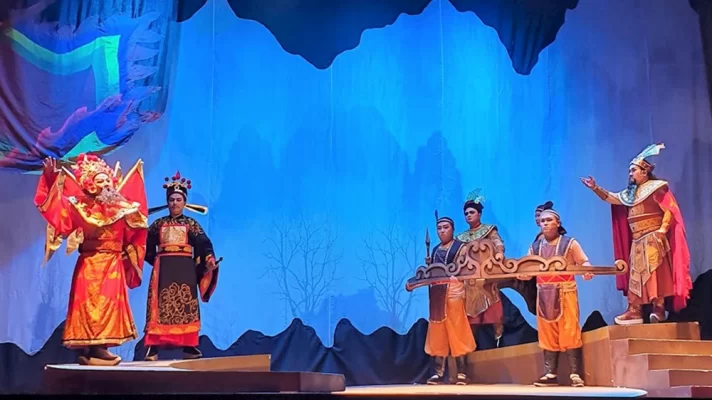
Tuong Art
Tuong art originated in the 17th century under the Nguyen Lords’ rule. During the Nguyen Dynasty, Tuong became the national theater and was highly esteemed. The Nguyen court enacted many policies favorable to the development of Tuong art. Today, you have the opportunity to explore theaters such as Duyet Thi Duong, Tinh Quang Institute, and Thong Minh Duong. During the Minh Mang Dynasty, the king built Thanh Binh Palace to train Tuong actors. King Tu Duc established the Ban Hieu Thu (Department of Literature), specializing in editing, refining, and creating Tuong plays.
2. Hue Folk Songs
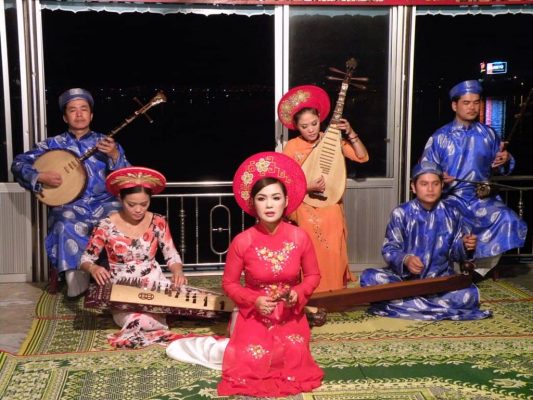
Ca Hue
Hue folk songs has its own characteristics with deeply sentimental qualities that stir the hearts of listeners, encapsulating the life’s experiences of the people of Hue. Hue folk songs has a strict and rigorous structure. When performing, it combines with the quintet of Tranh, Ty (a plucked string instrument), Nhi (a bowed string instrument), Nguyet (a moon-shaped lute), Tam, along with Bau (a monochord), Sao (flute), and Hue percussion instruments, creating profound melodies that touch the souls of the listeners.
Today, participating in a cultural tour and sitting on a dragon boat gently sailing on the Perfume River, listening to the soulful Hue folk songs, is a distinctive cultural experience of this destination that travelers should not miss.
3. Hue Royal Court Music
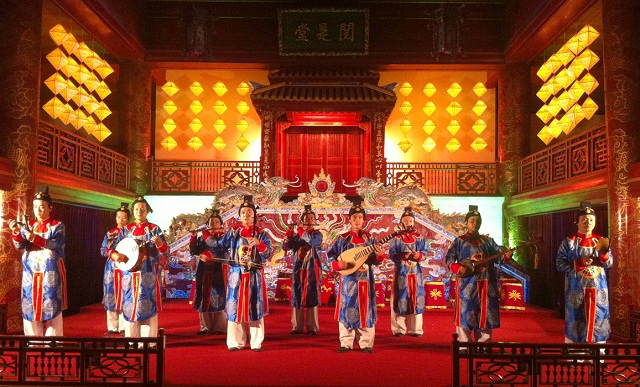
Hue Royal Court Music
Hue Royal Court Music refers to the formal music used in the ancient imperial court for ceremonies and royal events, blending ritual and music. It originated in the Le Dynasty, but it was not until the Nguyen Dynasty that it developed systematically and comprehensively. Hue Royal Court Music was recognized by UNESCO as an intangible cultural heritage in 2003.
4. Royal Court Dances
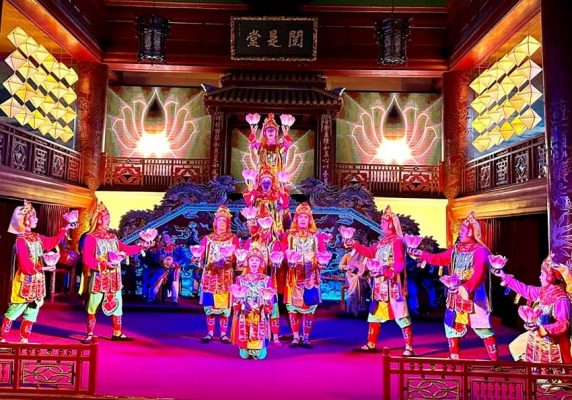
Royal Court Dances
Royal Court Dances are a product inherited from the feudal regime for thousands of years and crystallized under the Nguyen Dynasty. There are over 15 major dance productions, ranging from ritual dances and banquet dances to theatrical performances.
These performances are often grandly organized, with a large number of participants showcasing the vibrant beauty and demonstrating the exquisite dance techniques honed over thousands of years by the Vietnamese people.
5. Hue Festivals
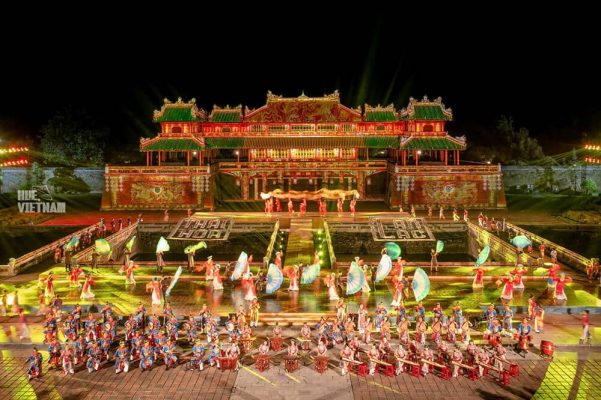
Hue Festivals
When you travel to the ancient capital, you’ll experience two types of Hue Festival: court festivals and folk festivals. Court festivals focus more on rituals than festivities, reflecting the ceremonial life of the court.
Folk festivals include a variety of vibrant celebrations, such as the Hu Nam festival in Hon Chen according to the beliefs of the Champa people, festivals commemorating village founders, and festivals honoring traditional craft guilds. During the festive seasons at folk festivals, cultural activities such as tug-of-war, wrestling, boat racing, etc. attract the attention of tourists.
6. Hue Cuisine
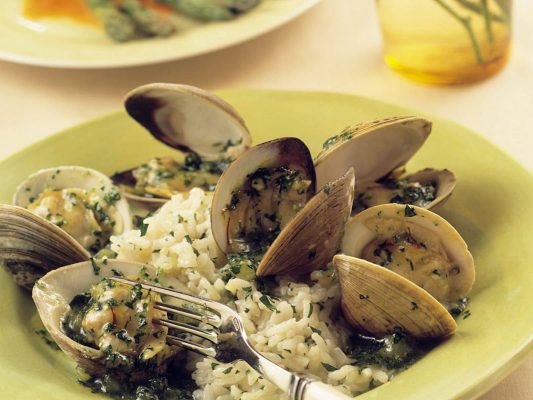
Clam rice
Speaking of Hue cuisine, you can’t help but admire their intricate cooking techniques and presentation. Just by taking a tour around the city to enjoy famous specialties like beef noodles, clam rice, clam noodle soup, various specialties cakes, and Hue-style desserts, you’ll feel that there’s never enough time to fully appreciate these dishes.
IV. Best Time To Visit Hue
1. From January to March
From January to March is the transitional period between winter and spring, as the cold gradually dissipates and gives way to warm sunlight. Hue at this time seems to adorn itself with a completely new outfit, brimming with vitality. If you choose for visiting during this season, you’ll encounter the image of a land of ancient capital adorned with fresh greenery, imbued with the flavor of the New Year.
2. In April: Festival Season
If you’re fond of the dreamy ambiance of Hue, you may choose to visit during the festival season, which typically falls around April each year. During this time, tourists will discover the unique and distinctive cultural aspects of this dreamy city.
3. From May to July: Beach Tourism Season
The beach tourism festival usually takes place from May to July, which coincides with the hottest period. During this time, visitors can immerse themselves in the clear blue waters of Lang Co Beach, enjoy the refreshing breezes, and experience the pristine white waves of Thuan An Beach.
4. In August
In August, Hue enters the romantic season of autumn. Autumn often passes by quickly, so much so that you might find it hard to catch up. During this time, the city will begin to experience light, gentle rains, cooler weather, and less sweltering heat than in the summer. Traveling in the autumn is perfect for visiting famous pagodas and historical landmarks.
5. From September to December
For those who love winter and wish to experience the chilly atmosphere, September to December is the ideal time to plan a trip. During this season, you’ll experience winter in the ancient capital, fully immerse yourself in the rainy season, and indulge in street-side grilled dishes.
V. Hue Attractions
1. Imperial City of Hue
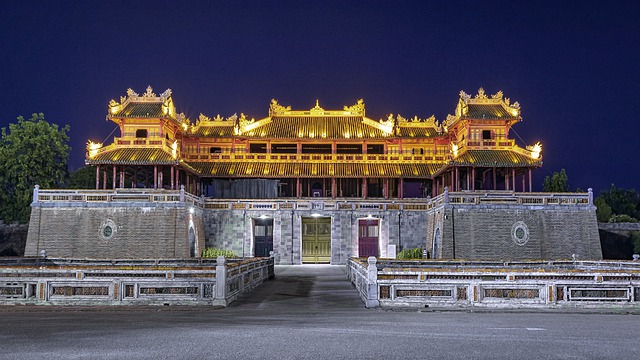
Imperial City of Hue
When talking about the famous Hue Citadel complex, you definitely can’t miss the Imperial City of Hue. The Imperial City comprises the Forbidden Purple City and the Hue Royal Palace, with over 100 remarkable architectural structures built during the Nguyen Dynasty and preserved to this day.
The Imperial City of Hue has witnessed countless historical ups and downs, accompanied the people of the ancient capital through many decades, and has been recognized by UNESCO as a World Cultural Heritage Site for about 30 years.
2. The Thien Mu Pagoda
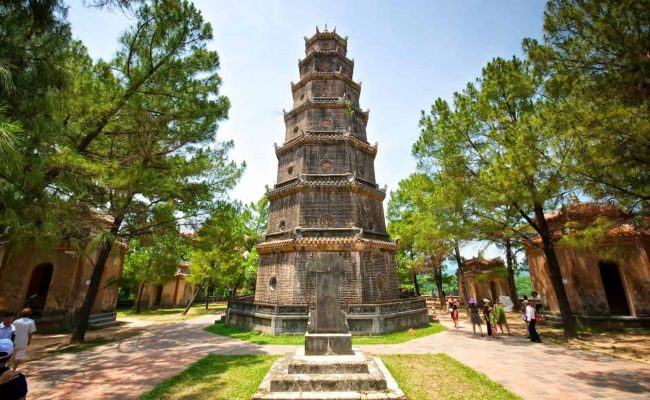
Thien Mu Pagoda
Thien Mu Pagoda is an ancient pagoda over 400 years old, located on Ha Khe Hill. Although not as grandiose as some architectural marvels, Thien Mu Pagoda always exerts a great attraction to a large number of tourists visiting Hue and has become a symbol of the city for generations. If you have the opportunity to visit this beautiful city, you must visit Thien Mu Pagoda to check in and experience the tranquility amidst the bustling city.
3. Dong Ba Market
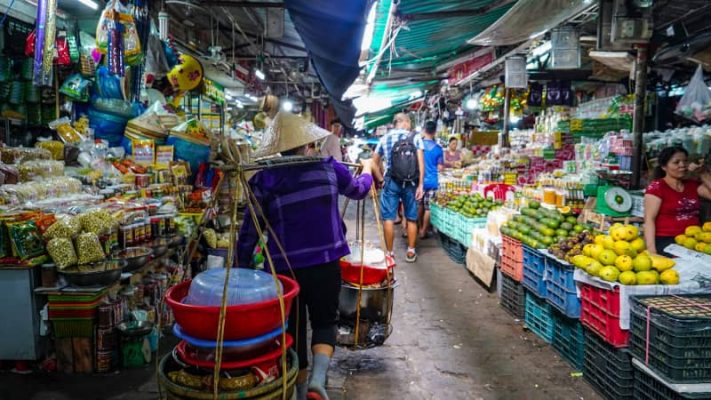
Dong Ba Market
If you’ve had the chance to visit the acient capital, Dong Ba Market is undoubtedly a must-visit highlight of Thua Thien Hue tourism. It is the largest market in the city, with a history spanning over 120 years. Dong Ba Market provides a full range of essential items, featuring famous specialties of the city, and tourists can come here to buy these items as gifts for friends and family.
4. Thuy Xuan Incense Village
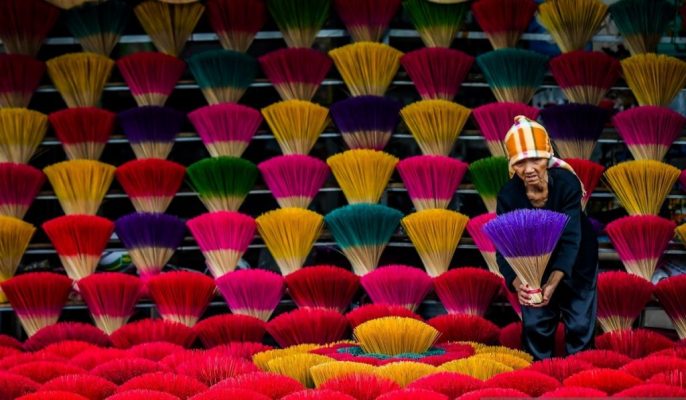
Thuy Xuan Incense Village
Thuy Xuan Incense Village is a renowned traditional craft village located at the foot of Vong Canh Hill, which has existed for many centuries. Here, incense products are highly regarded for their excellent quality, supplying the royal court, traders, and ordinary people.
During your trip, you can choose to visit this traditional craft village to gain a better understanding of the incense-making profession and the local people’s way of life. Especially the vibrant colors of incense sticks, elegantly arranged, have become the perfect backdrop for your “live virtual” photos.
5. Khai Dinh Tomb
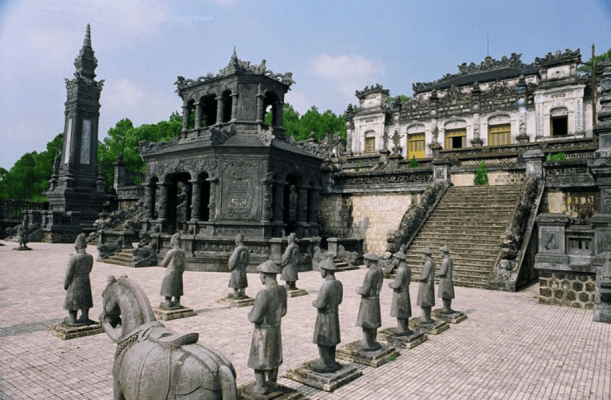
Khai Dinh Tomb
Khai Dinh Tomb is a remarkable architectural work that combines both Eastern and Western classical styles. Khai Dinh Tomb is considered one of the famous tourist destinations, loved by many tourists for its exquisite architecture and high artistic value. If you have time to visit Khai Dinh Tomb, you can also explore other royal tombs of the kings, such as Duc Duc Tomb, Dong Khanh Tomb, etc.
6. Minh Mang Tomb
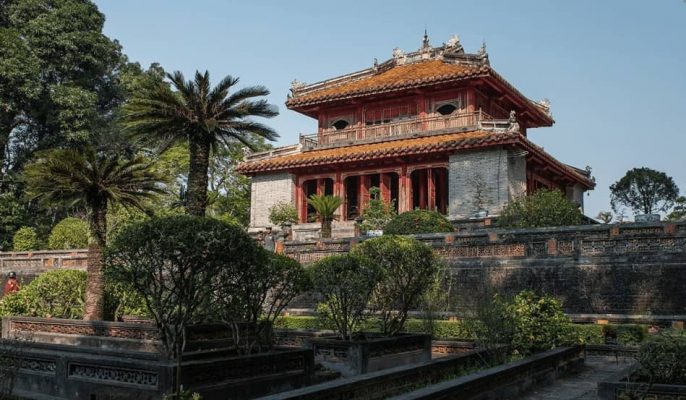
Minh Mang Tomb
Minh Mang Tomb, also known as Hieu Tomb, is the burial place of the king who made the greatest contributions to the country’s development at that time. King Minh Mang spent 14 years searching for the best feng shui to build his own tomb. Finally, he chose Cam Khe Mountain, where the Luu Trach and Ta Trach rivers converge to form the famous Perfume River.
7. Tu Duc Tomb
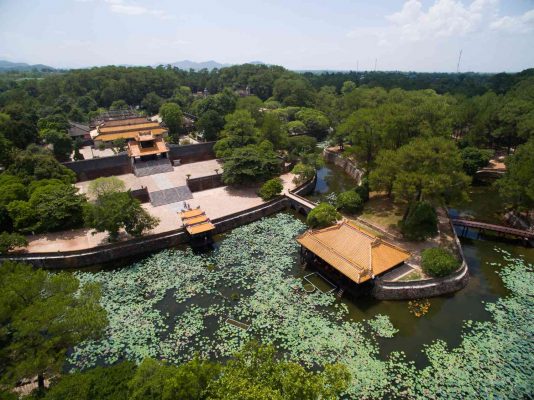
Tu Duc Tomb
Hue is famous for its unique architectural tombs, among which the Tu Duc Tomb is a typical example. This place features picturesque landscapes and was built according to the wishes of King Tu Duc before his passing, exuding a melancholic tone and a hint of sadness due to the many misfortunes in his life.
8. Lang Co Beach
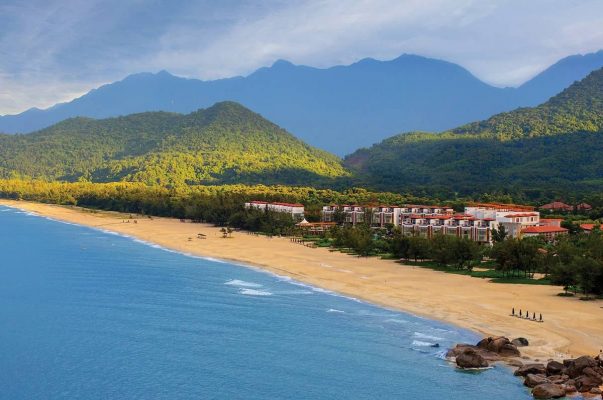
Lang Co Beach
Lang Co Beach, also known as Lang Co Bay, is famous for its beautiful beach, once voted as one of the most beautiful bays in the world. During a Hue tour, tourists can spend a full day relaxing at luxury resorts on Lang Co Beach, enjoying various fresh and delicious seafood dishes, and especially getting a better understanding of the lives of fishermen in the fishing village.
VI. Cultural Experiences of Hue
1. Engaging with Local Residents
The people of Hue are known for their gentle and refined demeanor, shaped by centuries of royal heritage and a deep respect for tradition. Travelers often find locals to be warm, courteous, and naturally reserved, embodying a distinct sense of grace unique to the region. Their welcoming nature invites visitors to engage in meaningful conversations, offering insights into life in a city that has long served as the cultural heart of Vietnam. Hue residents take pride in preserving their customs and enjoy sharing their city’s history and unique character with visitors.
2. Participating in Traditional Cultural Activities
Hue offers various cultural workshops and hands-on experiences that allow travelers to dive deeper into the city’s traditions. For instance:
- Cooking Classes: Join a local cooking class to learn the secrets behind Hue’s signature dishes, known for their royal influence and complex flavors. Participants can learn to prepare traditional dishes like bun bo Hue (Hue beef noodle soup) and savory rice cakes, such as banh beo and banh nam, which reflect the sophisticated palate of the region.
- Crafting Conical Hats: Visitors can participate in workshops that teach the traditional craft of making non la, the iconic conical hat. This hands-on experience, often held in nearby craft villages, allows visitors to create a beautiful, practical souvenir and gain an appreciation for the time-honored skill involved in crafting these cultural symbols.
- Listening to Royal Court Music: Hue is the birthplace of Nhã nhạc cung đình Huế, an imperial court music recognized by UNESCO as an Intangible Cultural Heritage of Humanity. Guests can attend live performances on the Perfume River or at cultural venues across the city to experience the majestic sounds and elegance of this historic music genre.
3. Exploring museums and art centers
The Hue Museum of Royal Fine Arts: Located within the former Long An Palace, this museum houses a remarkable collection of artifacts from the Nguyen Dynasty, including royal costumes, ceramics, and intricately crafted furnishings. It provides a unique glimpse into the opulent lifestyles and aesthetic sensibilities of the Vietnamese royal family.
Local Art Galleries and Craft Centers: Hue is home to several galleries that showcase the work of local artists and artisans, highlighting traditional Vietnamese techniques and contemporary interpretations. The city also has craft centers where visitors can witness artisans at work, producing lacquerware, embroidery, and calligraphy, each reflecting the artistic heritage of Hue.
Le Ba Dang Art Museum: This museum is dedicated to the works of renowned Vietnamese artist Le Ba Dang. It displays a stunning collection of his paintings and sculptures, which blend traditional Vietnamese themes with modern artistic expressions, providing insight into both the artist’s journey and the wider Vietnamese cultural landscape.
See more: Hue Travel Tips

